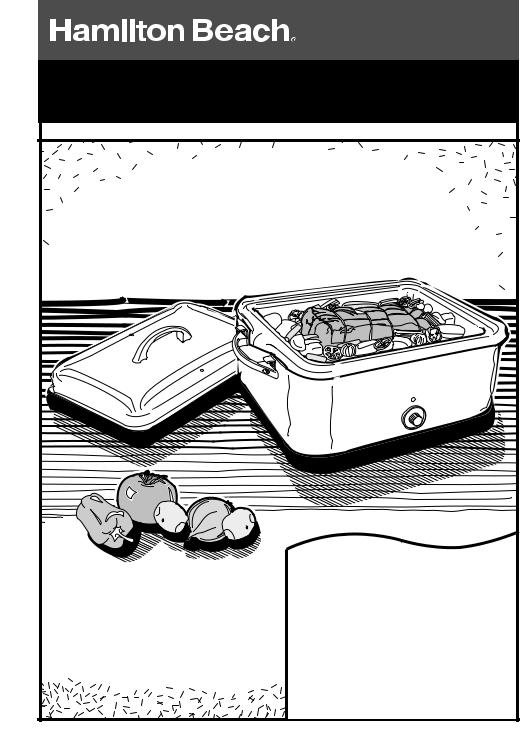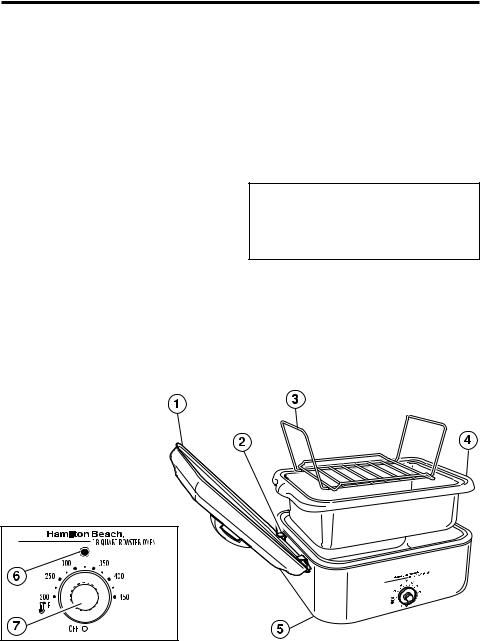Hamilton Beach Roaster Oven User Manual

Roaster Oven
Roaster Oven Safety...................... 2 |
Parts & Features.............................. 3 |
Using Your Roaster Oven.............. 4 |
Roasting.......................................... 5 |
Cleaning Your Roaster Oven........ 7 |
Roaster Oven Recipes .................. 8 |
Customer Service........................ 16 |
In USA: 1-800-851-8900 |
In Canada: 1-800-267-2826 |
840071900 |

Roaster Oven Safety
IMPORTANT SAFEGUARDS
When using electrical appliances, basic safety precautions should always be followed, including the following:
1.Read all instructions.
2.Do not touch hot surfaces. Use handles or knobs.
3.Use oven mitts to remove the insert pan from the roaster oven; or to remove a baking pan or cooked food from the insert pan.
4.To protect against electrical shock do not immerse roaster base, cord, or plug in water or other liquid.
5.Close supervision is necessary when any appliance is used by or near children.
6.Unplug from outlet when not in use and before cleaning. Allow to cool before putting on or taking off parts and before cleaning.
7.Do not operate any appliance with a damaged cord or plug, or after the appliance malfunctions or has been dropped or damaged in any manner. Call our toll-free customer service number for information on examination, electrical repair, mechanical repair, or adjustment.
8.The use of accessory attachments not recommended by the appliance manufacturer may cause injuries.
9.Do not use outdoors.
10.Do not let cord hang over edge of table or counter, or touch hot surfaces, including the stove.
11.To disconnect, turn any control to “Off” then remove plug from wall outlet.
12.Do not place on or near a hot gas or electric burner, or in a heated oven.
13.Extreme caution must be used when moving an appliance containing hot oil or other hot liquids.
14.CAUTION: Steam escaping from under cover is hot and can burn.
15.Do not use without the insert pan specifically designed for this model.
16.Do not use appliance to melt wax or any other non-food use.
17.Do not allow flammable materials such as curtains, draperies, walls, cabinets, backsplashes and the like to touch any part of the roaster oven while it is in operation.
18.Do not use appliance for other than intended use.
SAVE THESE INSTRUCTIONS!
2

Consumer Safety Information
This roaster oven is not intended for commercial, professional, or industrialtype usage. This roaster oven is designed only for cooking food. It should not be used for melting wax. This appliance
is designed, built, and intended for household use only.
This appliance is equipped with a polarized plug. This type of plug has one blade wider than the other. The plug will fit into an electrical outlet only one way. This is a safety feature intended to help reduce the risk of electrical shock. If you are unable to insert the plug into the outlet, try reversing the plug. If the plug should still fail to fit, contact a qualified electrician to replace the obsolete outlet. Do not attempt to defeat the safety purpose of the polarized plug by modifying the plug in any way.
The length of the cord used on this appliance was selected to reduce the hazards of becoming tangled in, or tripping over a longer cord. If a longer cord is necessary an approved extension cord may be used. The electrical rating of the extension cord must be equal to or greater than the rating of the roaster oven. Care must be taken to arrange the extension cord so that it will not drape over the countertop or tabletop where it can be pulled on by children or accidentally tripped over.
PLEASE READ THIS BOOK! THE ROASTER OVEN COOKS SOME FOODS FASTER THAN A CONVENTIONAL OVEN.
Parts & Features
1. Cover
2. Cover Holders
3. Rack
4.18 Quart Removable Insert Pan
5. Base
6. Indicator Light
7. Temperature Control
3

Using Your Roaster Oven
BEFORE FIRST USE: Wash the insert pan, rack, and cover before using. During the first use of the roaster oven, some smoke and odor may be noticed. The smoke and odor should not occur after this first heating of the oven.
Notes About Your Roaster Oven
•The insert pan must always be used when cooking in the roaster oven. If cooking large quantities of soups or stews, the insert pan may be used as the cooking pan in the roaster base. It may also be used as a large roasting pan in the roaster base.
•Do not use the insert pan as a baking pan or casserole dish for cakes, breads, or casseroles. A separate pan must be placed in the insert
pan when cooking these foods.
•Most heat-resistant glass casserole dishes fit in the roasting oven. Place in insert pan before filling dish to make sure it fits.
•Baking pans and casserole dishes should be placed on the rack for best heat circulation. If necessary, the rack can be removed to fit a large roasting pan or two casseroles in
the roaster oven.
•Before baking or roasting in the roaster oven, make sure the pan or dish you plan to use will fit by placing it in the insert pan.
•Foil oven roasting bags can be used in the roaster oven. We do not recommend using plastic oven roasting bags in the roaster oven.
•Do not remove the cover of the roaster oven unless necessary. Removing the cover allows heat to escape and affects the temperature of the roaster oven.
•The indicator light will cycle on and off when the oven is heating to maintain set temperature.
Pan Sizes!
Following are pan sizes which will fit in the roaster oven:
• One 9 x 13-inch baking or
10 x 14-inch roasting pan
•Two 9 x 5-inch or 8 x 4-inch loaf pans
•One tube or bundt pan
4

How to Use
Notes!
•The insert pan should always be placed in the roaster base when cooking.
•If the recipe calls for a preheated oven, set the temperature control to desired temperature. The red indicator light will go out when the oven has reached the set temperature.
1.Make sure temperature control is turned to OFF. Plug cord into 120 volt AC outlet.
2.Remove rack. Leave insert pan in roaster oven.
3.Set temperature control to desired setting and let preheat 15 minutes.
4.Place food to be cooked in a pan on the rack (or directly in the insert pan). Then place rack in oven and replace the cover.
5.When finished cooking, remove cover. Wearing oven mitts, remove food by using the rack.
6.Turn temperature control to OFF and unplug roaster oven.
Roasting
Roasting Meats and Poultry
•We recommend the use of a meat thermometer to assure perfectly cooked roasts and poultry every time. If using a meat thermometer, the meat or poultry should be removed from the roaster oven when the thermometer reading is 5 to 10 degrees below the desired temperature. The internal temperature will continue to rise after the meat has been removed from the roaster oven.
•Most hams sold today are labeled as “Cook Before Eating” or “Fully Cooked.” Ham labeled “Cook Before Eating” has been smoked or cured but NOT cooked. This ham must be thoroughly cooked to an internal temperature of 155 to 160°F. The “Fully Cooked” hams have been smoked or cured and already cooked. The ham does not require further cooking, but heating to 140°F improves the flavor.
•The roaster oven cooks turkeys in less time than conventional ovens. A 14 to 18 pound unstuffed turkey will cook in approximately 21⁄2 hours. A turkey cooked in the roaster oven is moist and juicy, but does not brown. If you want a turkey with browned skin, please use the Turkey Browning Sauce in the “Recipe” section.
•The Roasting Chart lists cooking times for tender cuts of meat that are usually dry-roasted. These roasts
are from the rib or sirloin area. To tenderize cuts from the leg (ham) or shoulder/chuck area, cook in liquid for a longer period of time.
•Times indicated are approximate and should be used only as a general guideline. Individual cuts of meat and personal preference may dictate longer or shorter roasting times.
5
